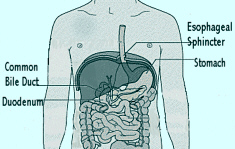Heartburn is a burning sensation in the substernal area caused by reflux of the stomach's
acid contents into the lower esophagus. It may occur in any one at any age, and is often
noticed in those who include running in their exercise regimen, whether or not food is
present in the stomach. Heartburn and other conditions that affect the esophagus are now
called Gastroesophageal Reflux Disease (GERD). While heartburn may be occasional or chronic,
GERD is a chronic disease which may require treatment on a long-term basis. Some studies
have shown a direct link between obesity and gastroesophageal reflux disease.
Helpful Links:
Heartburn
(Gastroesophageal Reflux Disease)
ffecting approximately
60 million Americans, heartburn is a very common occurrence. Conditions that cause reflux
of stomach acids into the esophagus are now referred to as Gastroesophageal Reflux Disease
(GERD) rather than chronic heartburn or acid indigestion. Heartburn may be accompanied by gas,
bloating, shortness of breath, an acidic or sour taste in the throat, or nausea. It begins
when an individual ingests food or drink. The pharynx and esophagus are the path by which
ingested food and drink reach the stomach. Once food reaches the stomach, it is partially
digested into a solution of hydrochloric acid, enzymes, and food particles. The stomach then pushes the
partially digested food into the duodenum and small intestine to be further digested and
absorbed. Heartburn is caused when the hydrochloric acid solution from the stomach backs up
into the esophagus and causes tissues to become irritated or inflamed. Gastroesophageal
reflux disease can scar the esophagus, and if stomach acids get into the lungs, asthma-like
symptoms may occur. Gastroesophageal reflux can also lead to a condition called
"Barrett’s Esophagus" in which
changes in the cells lining the esophagus can induce cancer.
 Studies have shown that deglycyrrhizinated
(DGL) Licorice is especially
helpful in alleviating some of the discomfort and pain of heartburn. It is an antispasmodic
and has proved to reduce stomach acid. Scientific studies have also shown that when taken
30 minutes before meals,
Gentian root is a remarkable heartburn preventative that aids digestion as well.
Also aiding in poor digestion,
Valerian root,
a bitter digestive stimulant and sedative, is helpful, as is
Wild Yam which is
antispasmodic and anti-inflammatory as well.
Studies have shown that deglycyrrhizinated
(DGL) Licorice is especially
helpful in alleviating some of the discomfort and pain of heartburn. It is an antispasmodic
and has proved to reduce stomach acid. Scientific studies have also shown that when taken
30 minutes before meals,
Gentian root is a remarkable heartburn preventative that aids digestion as well.
Also aiding in poor digestion,
Valerian root,
a bitter digestive stimulant and sedative, is helpful, as is
Wild Yam which is
antispasmodic and anti-inflammatory as well.
 These
products are available from our
Virtual Store.
Our liberal
Money Back Guarantee applies.
These
products are available from our
Virtual Store.
Our liberal
Money Back Guarantee applies.